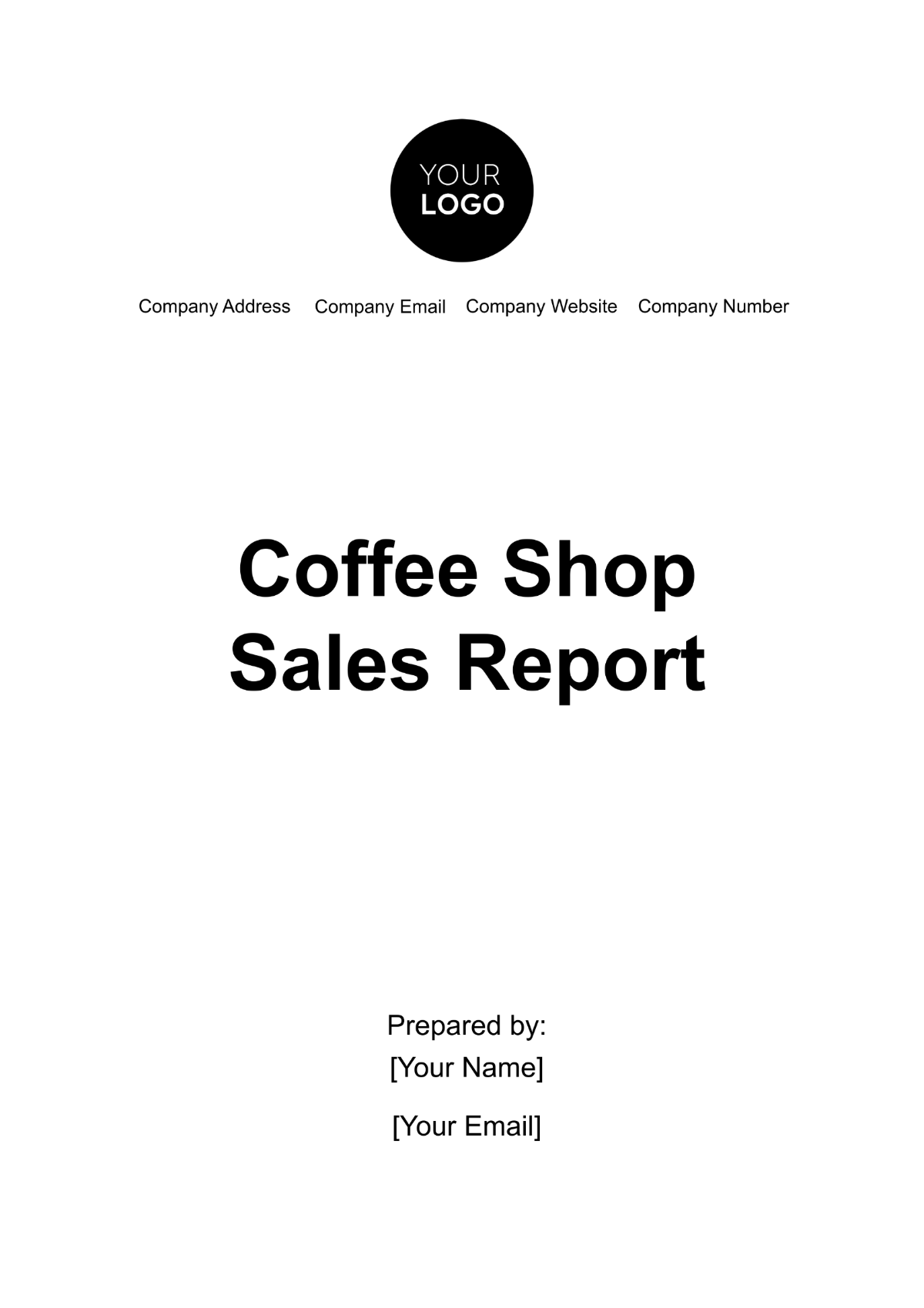Grocery Store Sales Report
I. Executive Summary
A. Purpose of the Report
[Your Company Name]'s report aims to evaluate the grocery store's sales performance for July [Year], highlighting key metrics and trends. It serves as a tool for assessing operational efficiency and guiding strategic decisions. By analyzing sales data, the report provides actionable insights to optimize store performance and enhance profitability.
B. Key Findings
Total Sales
The month of July in the year [Year] generated a total of $[00] in sales. This amount represents an increase of [00] percent compared to the sales figures recorded in June of the same year, and it also signifies an increase of [00] percent when compared to the sales figures from July of the previous year.
Departmental Growth
The produce department observed a significant increase in its growth rate, recording an impressive [00]%. This notable rise was primarily fueled by the heightened seasonal demand for fresh fruits and vegetables, which saw a substantial surge in consumer interest and purchases over the given period.
Profitability
The profit margin of the store remained steady at [00] percent, which indicates that the store maintained consistent financial health even in the face of fluctuations in the market.
C. Recommendations
Promotional Strategies
Place a greater emphasis on marketing and promotional activities within the dairy and bakery departments in order to significantly increase sales figures and draw in a larger customer base. Achieve this by aggressive advertising, engaging events, special discounts, and brand collaborations to boost interest and revenue in the supermarket.
Inventory Management
In order to prevent stockouts and avoid losing sales, it would be beneficial to implement a strategy that involves replenishing the inventory of high-demand items on a more frequent basis. This approach ensures that these popular products are consistently available to meet customer demand, thereby maintaining steady sales and improving overall customer satisfaction.
Supplier Evaluation
It is advisable to investigate and consider working with a variety of different suppliers. By doing so, the goal would be to reduce or mitigate any disruptions that might occur within the supply chain, and that could potentially impact the availability of top-selling products. This approach would help in ensuring a more reliable and consistent inventory, thereby avoiding potential stock shortages or delays.
II. Sales Overview
A. Total Sales
Summary of Total Sales Figures
In the month of July [Year], the store achieved total sales amounting to $[00]. This accomplishment signifies a [00]% increase in comparison to the month of June [Year], during which the store's sales amounted to $[00].
The observed increase in sales can be attributed to two primary factors: a significant rise in the number of customers visiting the store, commonly referred to as higher footfall, and the successful implementation of highly effective promotional campaigns throughout the month.
Comparison to Previous Periods
In July of [Year], sales surpassed those of July in the preceding year by a remarkable [00]%. This significant increase reflects a noticeable enhancement in store performance and customer engagement. To provide a clearer perspective, the sales figures from the previous year stood at $[00], underscoring the substantial progress made over the course of a year.
B. Sales by Department
Department | Sales ($) | Month-over-Month Growth (%) |
|---|---|---|
Produce | $[00] | [00]% |
Dairy | $[00] | [00]% |
Meat | $[00] | [00]% |
Bakery | $[00] | [00]% |
Other | $[00] | [00]% |
Produce: Sales reached $[00], showing an [00]% increase from June. The growth is due to the seasonal peak in fresh fruits and vegetables.
Dairy: The dairy department saw $[00] in sales, a [00]% increase. Enhanced promotional offers contributed to this growth.
Meat: Sales were $[00], marking a [00]% increase, driven by strong demand for premium cuts.
Bakery: Sales of $[00], with a [00]% increase, reflecting steady consumer interest in baked goods.
Other Departments: Generated $[00] in sales, up by [00]%, with minimal change from the previous month.
C. Sales by Product Category
Department | Sales ($) | Month-over-Month Growth (%) |
|---|---|---|
Groceries | $[00] | [00]% |
Household Items | $[00] | [00]% |
Beverages | $[00] | [00]% |
Personal Care | $[00] | [00]% |
Groceries: This category generated $[00] in sales, marking a [00]% increase from June. The growth was supported by increased promotions and discounts.
Household Items: Sales of $[00] represented a [00]% increase, driven by new product lines and marketing efforts.
Beverages: With sales of $[00], the beverages category experienced a [00]% growth, attributed to seasonal demand for cold drinks.
Personal Care Products: Sales of $[00], up by [00]%, reflecting consistent consumer interest in personal care essentials.
III. Financial Metrics
A. Gross Revenue
Total Gross Revenue
Gross revenue for July [Year] was $[00]. This figure includes all sales before any deductions.
Comparison to Previous Periods
The gross revenue increased by [00]% from June [Year], where it was $[00]. This indicates effective sales strategies and higher customer spend.
B. Net Revenue
Metric | July [Year] | June [Year] |
|---|---|---|
Gross Revenue | $[00] | $[00] |
Returns and Discounts | $[00] | $[00] |
Net Revenue | $[00] | $[00] |
Revenue After Returns, Discounts, and Allowances
Net revenue for July [Year] was $[00], after deducting $[00] in returns and discounts. This represents an increase from June’s net revenue of $[00].
Comparison to Previous Periods
The net revenue saw a [00]% increase from June [Year], reflecting improved sales performance and effective management of returns.
C. Profit Margin
Metric | July [Year] | June [Year] |
|---|---|---|
Profit Margin | [00]% | [00]% |
Cost of Goods Sold | [00]% | [00]% |
Calculation of Profit Margin
The profit margin for July [Year] was [00]%, consistent with the margin in June [Year]. This is calculated as (Net Revenue - Cost of Goods Sold) / Net Revenue.
Historical Comparison
The stable profit margin indicates effective cost control and pricing strategies, maintaining profitability despite market fluctuations.
IV. Sales Trends and Analysis
A. Monthly Trends
Sales Performance by Month
July [Year] showed a steady upward trend in sales, driven by increased customer traffic and successful promotions. Monthly sales have shown a consistent increase over the past six months.
Identification of Seasonal Trends
Seasonal demand for fresh produce contributed to higher sales in the produce department. Historically, summer months see a spike in fruit and vegetable sales.
B. Year-over-Year Comparison
Metric | July [Year] | June [Year] | Year-over-Year Growth (%) |
|---|---|---|---|
Total Sales | $[00] | $[00] | [00]% |
Net Revenue | $[00] | $[00] | [00]% |
Sales Comparison with the Same Period Last Year
Sales in July [Year] increased by [00]% compared to July [Year]. This growth is attributed to better marketing strategies and enhanced product offerings.
Analysis of Growth or Decline
The year-over-year growth reflects improved customer engagement and successful implementation of sales strategies, contributing to a stronger market position.
C. Daily Sales Patterns
Day of the Week | Sales ($) | Percentage of Total Monthly Sales (%) |
|---|---|---|
Monday | $[00] | [00]% |
Tuesday | $[00] | [00]% |
Wednesday | $[00] | [00]% |
Thursday | $[00] | [00]% |
Friday | $[00] | [00]% |
Saturday | $[00] | [00]% |
Sunday | $[00] | [00]% |
Sales by Day of the Week
Sales data reveals that Saturdays and Sundays have the highest sales, contributing [00]% of the total monthly sales. This trend suggests higher foot traffic during weekends.
Peak Shopping Times
Peak shopping times occur between 2 PM and 5 PM daily, with the highest customer volume and sales during these hours. Adjusting staffing and inventory during peak times can further optimize sales.
V. Inventory and Stock Analysis
A. Stock Levels
Current Inventory Status
As of July [Year], the current inventory levels are well-maintained, with essential items stocked adequately. Regular inventory checks and automated replenishment systems have minimized stock discrepancies. This has ensured product availability and customer satisfaction.
Comparison with Sales Volume
Inventory levels are aligned with sales volume, reflecting effective stock management practices. High-demand items were consistently available, contributing to increased sales. This balance has helped in maintaining optimal stock turnover rates.
B. Stock Turnover Rate
Rate at Which Inventory Is Sold and Replenished
The stock turnover rate for July [Year] improved to 12 times, up from 10 times in June [Year]. This indicates a more efficient inventory management system. Faster turnover suggests that products are moving quickly off the shelves, reducing holding costs.
Comparison with Industry Benchmarks
Our turnover rate of 12 times surpasses the industry benchmark of 8 times. This places us ahead of many competitors in terms of inventory efficiency. Continuous monitoring and adjustment of stock levels have been key to achieving this performance.
C. Out-of-Stock Items
Frequency and Impact of Out-of-Stock Incidents
Out-of-stock incidents were minimal, occurring mainly with non-perishable items. Each incident was quickly addressed, minimizing potential sales losses. Ensuring regular communication with suppliers has been critical in preventing prolonged stockouts.
Recommendations for Improvement
To further reduce stockouts, increasing the frequency of orders for high-demand items is recommended. Additionally, enhancing the predictive analytics for inventory management can help anticipate demand spikes. This proactive approach will help maintain product availability and customer satisfaction.
VI. Customer Insights
A. Customer Footfall
Number of Customers Visiting the Store
In the month of July in the year [Year], the retail store observed a significant influx of 20,000 customers walking through its doors. This figure represents an impressive increase of [00] percent when compared to the customer foot traffic recorded in the preceding month of June. The management has attributed this notable rise in customer visits to a series of effective marketing campaigns as well as strategically timed seasonal promotions that were launched during this period. The heightened foot traffic has had a positive impact by directly contributing to the growth in overall sales for the store.
Comparison to Previous Periods
When looking at the customer footfall in comparison to the month of July in [Year], there has been an impressive increase of [00]%, as the number of visitors rose from 18,500. This consistent upward trend in the number of customers visiting the store speaks volumes about the improved customer retention and attraction strategies that have been implemented. The substantial rise in foot traffic has played a crucial role in boosting the store's overall sales performance, highlighting the effectiveness of these strategic enhancements in capturing and maintaining consumer interest.
B. Average Transaction Value
Calculation of Average Transaction Amount
In the month of July of the specified year, the average transaction value amounted to $[00]. This figure represents an increase from the average transaction value of $[00] recorded in the preceding month, June. The observed rise in the average transaction value can be attributed to higher spending per customer visit. One of the contributing factors to this increase is the successful implementation of upselling and cross-selling strategies.
Analysis of Spending Patterns
Customers exhibited a noticeable inclination toward premium products, a trend that significantly contributed to the elevated average transaction value observed during the analysis period. Additionally, the deployment of seasonal promotions and discounts acted as a motivating factor, prompting consumers to make larger purchases than they might have otherwise. By gaining insight into these specific spending behaviors and preferences, businesses can better strategize and customize their marketing efforts to align with consumer tendencies, thereby enhancing their overall effectiveness in future campaigns.
C. Customer Feedback and Satisfaction
Summary of Customer Feedback
Customer feedback has been overwhelmingly positive, particularly regarding product quality and store cleanliness. Several customers have also praised the helpfulness and friendliness of the staff. This feedback is crucial for maintaining high customer satisfaction levels.
Impact on Sales and Store Performance
High levels of customer satisfaction have resulted in increased repeat visits and higher sales. Positive word-of-mouth from satisfied customers has also attracted new shoppers. Continuous improvements based on customer feedback will further enhance store performance.
VII. Issues and Recommendations
A. Sales Issues Identified
Specific Problems Affecting Sales
One major issue identified is the limited promotional activity in the dairy and bakery departments. This has resulted in lower sales growth compared to other departments. Additionally, occasional stockouts of popular items have slightly impacted sales performance.
Impact on Overall Performance
The challenges that have arisen from these issues have resulted in numerous missed opportunities to maximize sales across various product categories. In order to sustain the overall performance of the store and ensure customer satisfaction, it is crucial that we address and resolve these challenges without delay.
B. Actionable Recommendations
Strategies to Address Identified Issues
To boost sales in the dairy and bakery departments, implementing targeted promotions and discounts is recommended. Enhancing the visibility of these departments through better signage and marketing can also attract more customers. Regular training sessions for staff on inventory management can reduce stockouts.
Implementation Plan and Timeline
By the start of August in the specified year, develop and launch new promotional campaigns. Additionally, within the next two weeks, conduct training sessions focused on inventory management. Furthermore, by the conclusion of the current quarter, review and make necessary adjustments to supplier agreements in order to ensure that the supply chain remains reliable.

















































